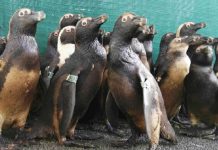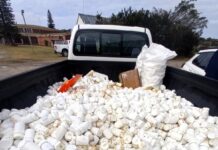World Migratory Bird Day 2019 on 11 May was a good reason to place the spotlight on the negative impact of plastic pollution on migratory birds, particularly ocean birds and their habitats.
The internationally-recognised day is an 2006 initiative launched by the Convention on the Conservation of Migratory Species of Wild Animals (CMS), an international body of the Agreement on the Conservation of African-Eurasian Migratory Waterbirds (AEWA), under the auspices of the United Nations Environment Programme.
It is celebrated twice a year, on the second Saturday in May and October, and this year the theme is Protect Birds: Be the Solution to Plastic Pollution!
Awareness campaign
The bi-annual campaign not only raises awareness about the need for conservation of migratory birds and their habitats, but also about the threats they face, their ecological importance and the need for international cooperation to conserve these species.
Migrating species
A number of common species migrate to South Africa every year. These are:
- Greater Striped Swallow which is endemic to Africa south of the equator. The species is found from southern Democratic Republic of Congo and Angola to Zambia and Southern Africa.
- Amur Falcon, which is found in south-eastern Siberia and Northern China before migrating in large flocks across India and over the Arabian Sea to winter in Southern Africa.
- White-rumped Swift which breed in much of sub-Saharan Africa and have expanded into Morocco and southern Spain. The populations in Spain, Morocco and the south of Africa are migratory, although their wintering grounds are not definitively known.
- White Stork which is found from tropical Sub-Saharan Africa to as far south as South Africa.
- Pygmy and Woodland Kingfishers which are found across sub-Saharan Africa and are intra-African migrant birds.
- Yellow-billed Kite. The European populations move south into sub-Saharan Africa and the Middle East, whilst populations north of Pakistan and the Himalayas travel into south Asia.)
International World Migratory Bird Day
The timing of the International World Migratory Bird Day (WMBD) is interrelated to the departure of migratory birds from the Southern Hemisphere to the Northern Hemisphere for the summer.
Most bird species migrate to areas where there is abundant food and nesting grounds annually. However, large numbers of birds are killed on their return flight from the Northern to the Southern Hemisphere due to anthropogenic behaviour, among others, plastic pollution.
Marine litter and plastic
Marine litter, including plastic litter, has become a matter of increasing global and national concern as a source of marine pollution. More than 300 million tons of plastics are produced annually, making it one of the most widely used materials worldwide.
The presence of plastic threatens migratory birds, either through entanglement in, for example, fishing nets, and ingestion of small items of plastic. Large numbers of birds are also smothered by plastic rings, and some seabirds such as cormorants, gannets and gulls have been seen incorporating plastic in their nesting materials.
In a research published in 2015, South Africa was ranked 11th in a list of top 20 countries for mismanaged waste, which could potentially become marine litter. Furthermore, over 80% of all marine litter is composed of plastic. Once plastics enter the environment it does not biodegrade, but simply breaks down into smaller pieces over time which becomes a greater threat for marine species once they have entered our oceans.
Adverse effects of plastic
The adverse effects of plastic on marine species has been receiving widespread attention globally for some time. AEWA indicates that the number of seabirds dying from the effects of plastic annually is one million, and growing.
Seabirds were among the first bird species to contain ingested plastic around the 1960’s. It is further suggested that at least 40% of all seabird species contain ingested plastic and some have been recorded entangled by plastic.
Petrels, albatrosses
Species such petrels, albatrosses, gulls and skuas have been observed to contain higher ingestion of plastics. Due to the vast distances travelled by some seabirds, plastics can be dispersed to uninhabited islands.
Existing research pinpoints the urgency of the matter: not only do 40% of seabirds have plastic in their guts, but this proportion will reach 99% by 2050 if there is no intervention.
Avitourism and conservation of birds
Avitourism, as it has come to be known, generates millions of rands annually, contributing significantly to GDP. It has also become a large job creator in South Africa.
In 2018, South Africa hosted two Meetings of Parties that deal with the conservation of birds. In May 2018, the 6th Meeting of Parties to the Agreement on the Conservation of Albatrosses and Petrels (ACAP) agreed to develop guidelines to quantify the ingestion of plastics by albatrosses and petrels which will include protocols for macroplastics and microplastics.
Again in December 2018, the 7th Meeting of the Parties to AEWA agreed on measures to tackle threats from climate change and to increase protection of individual species and seabirds. Furthermore, a study on plastic and waterbirds was commissioned by AEWA to look at the impacts that plastics have on waterbirds and suggested possible monitoring tools to track interactions between waterbirds and plastics.
Waterbird conservation issues
The Durban Plan of Action for Africa presented a renewed framework for responding to contemporary waterbird conservation issues in Africa. Among the Resolutions adopted was on AEWA’s contribution to the Aichi Targets and the Agreement’s relevance to the Sustainable Development Goals, strengthening the monitoring of migratory waterbirds, guidance on the implementation of the AEWA Action Plan, climate resilient flyways, financial and institutional arrangements.
South Africa has numerous interventions to dealing with marine litter including plastic pollution.
Working for the Coast Programme
The Department of Environmental Affairs has implemented its Working for the Coast Programme as an Extended Public Works Project aimed at creating jobs through dealing with challenges emanating from the coast, among which includes the clearing of litter from beaches nationally.
Additionally, in 2014, the Department launched its National Coastal Management Programme under the National Environmental Management: Integrated Coastal Management Act to prioritise the management of pollution in the coastal zone. Under that priority, South Africa adopted Management Objective 4.3, which is to develop and implement programmes to address marine litter.
Source-to-sea-Programme
The Department will also soon launch the Source-to-sea Programme to address the growing concern of litter from inland river systems, including catchment systems, therefore reducing marine litter. One of the other streams that has been prioritised by the Department is packaging waste, which includes plastic waste with the intent is to ensure that the industry commits to specific targets on the diversion of waste from landfill sites.
Marine Pollution. New Use for Purse Seine Nets
Fiscal and waste management policy amendment
Additionally, South Africa has amended its fiscal and waste management policy to introduce environmental levies for plastic bags and is looking at investments in plastic palletization plants which is also emphasised under Operation Phakisa initiatives as one of the best available ways to divert plastic waste from landfill sites.
Plastic Material Flows and End of Life Management Study
Lastly, South Africa has also conducted a Plastic Material Flows and End of Life Management Study to assess the current status with regards to the production and management of plastics and identified barriers to improving the diversion of plastics from landfill sites.
These interventions will assist events such as World Migratory Bird Day in protecting our delicate wildlife, and some are ideal opportunities for communities to take action in mitigating unnecessary injuries suffered by migratory birds as a result of plastic waste, and to contribute to a decrease in the mortality of these birds due to plastic pollution.




















